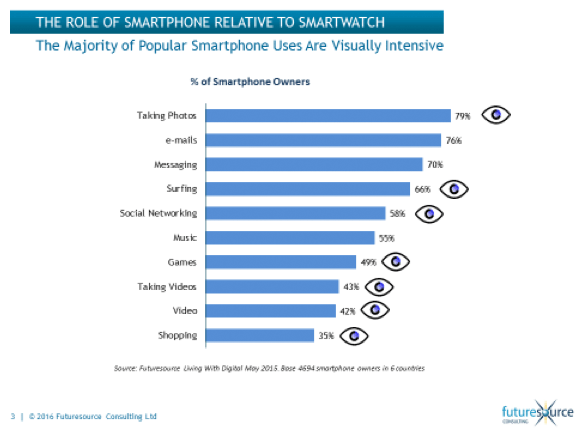Futuresource Consulting is about to release its latest Global Wearables Q4 2015 results, which highlights that 99 million devices were sold across all categories, growing by 76% year-on-year. Retail value was $24bn, increasing by 267% from the previous year, highlighting a marginal increase in the overall average selling price per device. This increase came from the connected watch category, were Apple quickly established itself as outright market leader despite being late to market compared to some of the other major brands.

According to the latest Futuresource market data smartwatches overtook activity trackers as the largest product type in revenue terms from the previous year. Q4 was also the first quarter which saw smartwatch shipments overtake the Swiss watch makers traditional watch volumes. Classic high end brands such as Tag Heuer and Breitling and mass consumer watch brands such as Fossil and Guess have already started to introduce connectivity and smart features to their watches in order to embrace changing customer needs and market competition.
“Fossil recently bought out technology start up Misfit, marrying watch making know how with wearable technology, we have been told to expect over 100 new connected devices in 2016,” commented Mariia Konovalova, Analyst at Futuresource Consulting. “The company were also quick to announce that Misfit’s wearable technology will be put into its Michael Kors watch range and will expand its product portfolio further throughout the year.”

The smartwatch is certainly a disruptive force in the health and fitness tech market. Futuresource Consulting reviewed the market shares of the key players in the fitness sector and all of them, bar Fitbit and Xiaomi, had lost share as watches have gained a meaningful foothold. The smartphone over the past few years has increasingly cannibalised MP3s, cameras, camcorders and more recently satnavs and tablets. Futuresource Consulting anticipates that smartwatches will continue to converge on the health and fitness wearables market as the components become more accurate, reliable and better able to compete with dedicated devices.
The exact direction and shape of this market is yet to be defined as there are so many potential applications, many consumers are still not sure how a smartwatch will benefit them in terms of lifestyle and practicality. Currently smartwatches need to be charged and feel extremely techy and bulky for many people, especially women. According to Futuresource’s consumer study, ‘Living with Digital (LWD) 11’, only 34% of smartwatch owners are women. However, women account for 60% of watch sales.
Smartwatches are of a certain size largely due to the restrictions of the silicon/wafer which has meant that they are typically larger than the size of watches worn by women, until now. Ongoing advancements by the integrated chip manufacturers means they can go smaller – which opens up the market for more petit, women’s watches, effectively increasing the TAM from less than 20% of all watches to over 60%.
At MWC there was a great deal of interest in the recent standard relating to embedded SIMs for CE devices, Samsung’s Gear S2 is the first Smartwatch from an international brand with this feature. Mobile network operators are showing real interest in this as it is not only a new device, but it also opens up the opportunities to upsell more airtime and additional services too.
Futuresource Consulting believes that smartwatches will get smarter and more capable but not at the expense of smartphones, at least not until the screen or display issue gets resolved as many smartphone applications are visually intensive. Other issues like battery life are also improving for smartwatches, Android Wear is up from 1 to 3 or 4 days, the Pebble Time Steel offers 10 days and the Vector models claim 30 days.



